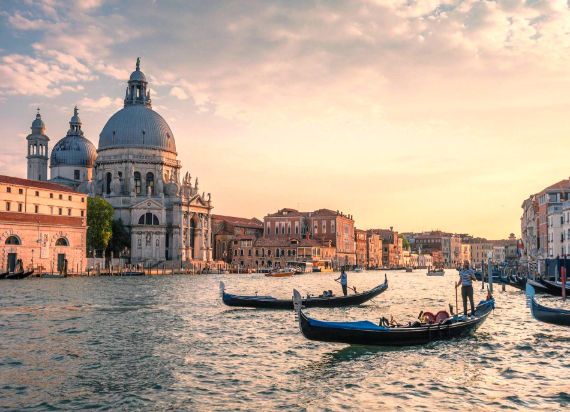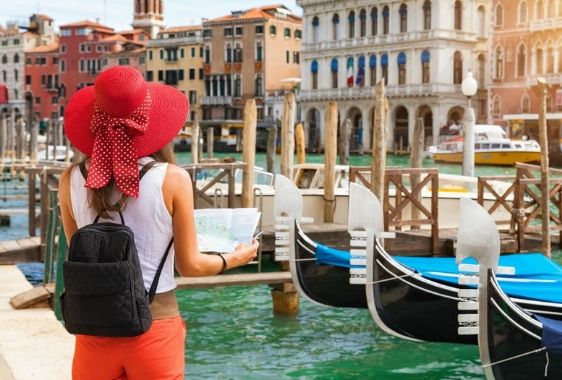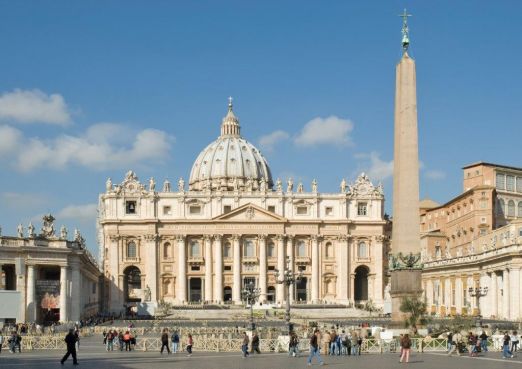The person who stands in this enormous cobble-stone and horse-shoe shaped piazza clearly owes a debt of gratitude to the great architects Bernini, Maderno and Michelangelo. Looking down from above the 284 columns of Bernini's colonnade, and from the rooftop of St. Peter's itself, are 140 larger-than-life statues of saints.
The Basilica of St. Peter was begun under the papacy of Julius II around 1506. As you enter the basilica, which has the traditional form of a Latin cross, several things will strike you: its sheer size, its incredibly ornate decoration and, most of all, the pervasive golden light that bathes every corner of the church. The central and side naves are filled with altars, monuments to the Popes, statues of the founders, intricate mosaics.
Dominating the apse is the monumental papal altar of Saint Peter in Glory, crowned by a highly theatrical gild bronze canopy, a masterpiece of Baroque energy by Bernini. Look directly overhead and you will see the dome designed by Michelangelo.
The highlight of any visit to St. Peter's is in the first chapel in the right nave, just beyond the entrance to the church. It is Michelangelo's "Pietà". This sculpture is, quite simply, mesmerizing, and a half hour can easily drift by as you stand transfixed in its presence.
Entrance to the dome is from the left aisle of the church. An elevator takes you as far as the first terrace above the nave. From here you have fine view of the Vatican City and beyond. If you want to climb beyond this level, you must do so on an endless and precarious one-way staircase. The reward for this grueling ascent is a spectacular panoramic view of Vatican City, Rome and beyond.
The Vatican Grottoes lie between the floor level of the old Constantinian basilica and the nave of the present church.The winding underground passageways lead past tombs of the great Popes, and the relics and sarcophagi that remain from the ancient basilica. The pre-Constantinian Necropolis is one of the most fascinating and mysterious areas of the Vatican.
In 1940, the remains of a Roman burial ground were discovered below the grotto level of St. Peter's, with the mausoleums of both pagans and early Christians clearly revealed.
Every time you turn the corner and look down the Via Conciliazione toward St. Peter's, your heart beats faster. Sometimes the great dome seems to float like a huge white chalice against the blue sky. On cloudy days it is brown and solid, a massive throne rooted deeply in the earth.
And at night it glows like a vast candle illuminating the sky. San Pietro, the largest church in the world, the mother church of Catholicism, the dominant sight in the Vatican City, the gravestone, in all probability of Peter the Fisherman.
As one walks down the broad street leading to the Vatican and see its garish political posters, its marble lampposts, its bustling sidewalk cafes, its procession of strangely clad ecclesiastical figures, and its occasional empty old church, the other side of a normal Roman reaction takes effect: anger, frustration, disappointment. St. Peter's led to the "selling of indulgences" to finance its construction, which even Catholic scholars today admit was outrageous, and led to Martin Luther's Reformation.
Drawing near the great piazza, read the legend across the top of the facade: Peter and Paul, the apostles in whose honor the church is dedicated, are mentioned off on the left-hand side, while the Borghese Pope who built the church receives top billing across the center.
One knows that the Church is made up of human beings with human faults who make human mistakes. Yet it is a bit much to walk down a street to a basilica constructed to flatter the ego of an arrogant Renaissance monarch.
But San Pietro is magnificent, with its dome from the Pantheon, and the aula of Diocletian's law court (the ruins of which can be seen in the Forum, and from which some of the marble to build St. Peter's, in a nice irony, was taken).
And if arrogant Renaissance monarchs have stood on its balcony, so too have saints. If the Reformation began with St. Peter's, so did the ecumenical era 20 years ago, when one of the greatest successors of Peter the Fisherman summoned the Second Vatican Council.
What is amazing about the Catholic Church is not that it makes mistakes, sometimes monumental ones. What is astonishing about it rather is that it still has the durability and the fresh youthfulness to produce a John XXIII and Second Vatican Council.
The mistakes may continue, but if Jesus wanted a Church in which no mistakes were made, he would not have entrusted it to humans. But let's see the inside of this Vatican City and what it means to the world.









